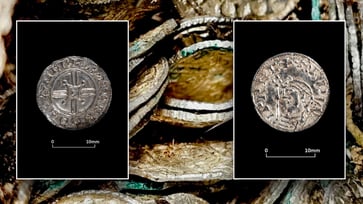Tracking the impact of human-caused extinction events throughout time
What are extinct species caused by humans? Investigate causes with a wildlife expert's insights.

Human activities are causing a severe threat to biodiversity through anthropogenic extinction.
The University of Florida's Wildlife Ecology and Conservation Department's Professor Bridget B. Baker discussed anthropogenic extinction, its causes, examples of affected species, and the future challenges and opportunities with Planet Chronicle Digital.
What is anthropogenic extinction?
Human influence on the environment is the cause of species disappearing from the Earth, which is known as anthropogenic extinction.
What species have been affected by anthropogenic extinction?
Due to factors such as habitat destruction, pollution, climate change, and hunting, some species have faced the fate of anthropogenic extinction.
Amphibians are at a higher risk of extinction due to chytrid fungus, which is a global invader that spreads through human travel and trade. Climate change weakens their immune systems, making them more vulnerable to the fungus, according to Baker.
Below are examples of animals impacted by anthropogenic extinction.
The passenger pigeon, once plentiful in North America, became extinct in the early 20th century due to hunting and habitat loss.


The bucardo, a species of Pyrenean ibex, once roamed the mountainous Pyrenees but became extinct in the 20th century.
The decline in this animal's population was caused by a combination of factors, including intense hunting driven by sport and commerce, as well as the spread of diseases.
In 2000, despite conservation efforts, the last Pyrenean Ibex, Celia, passed away.

The quagga, a unique subspecies of the plains zebra, once thrived in South Africa but became extinct in the late 19th century due to overhunting by European settlers and habitat changes.
The Quagga Project suggests that attempts have been made to revive the species' likeness through selective breeding, offering a glimpse into the possibility of restoring a population similar to the extinct subspecies, as the last recorded quagga died in captivity in 1883.

The golden toad, native to Costa Rica, became extinct in the late 20th century. Its distinctive appearance made it a symbol of Central American biodiversity.
The golden toad population struggled to adapt due to changes in its montane cloud forest habitat caused by shifting climate patterns.
The extinction of the golden toad was caused by habitat degradation and the chytrid fungus.

The Tasmanian tiger, scientifically known as thylacinus cynocephalus, was a carnivorous marsupial native to Tasmania, Australia, and New Guinea. This large dog-like creature with tiger-like stripes became extinct in the 20th century, with the last known individual dying in captivity in 1936.
The Tasmanian tiger's extinction was caused by intense hunting, human persecution, and habitat loss. Despite extensive efforts to find surviving animals, it remains a perfect example of anthropogenic extinction.
The monk seal that inhabited the Caribbean Sea and Gulf of Mexico was a marine mammal of the Caribbean.
In 2008, these mammals were classified as extinct mainly because of hunting, overfishing, and habitat destruction.
The western black rhinoceros became extinct in 2011 due to intensive hunting for its highly valued horn, which was used in traditional medicine and as a status symbol. This relentless hunting led to a significant decrease in the rhinoceros population, ultimately resulting in its extinction.

The tortoise native to Pinta Island in the Galapagos archipelago in Ecuador is known as the Pinta Island tortoise, or chelonoidis abingdoni.
In 2012, the last known Pinta Island tortoise, George, passed away, resulting in the extinction of his subspecies. George encountered challenges such as habitat degradation, invasive species, and human exploitation.

The vibrant blue parrot species native to Brazil, scientifically known as cyanopsitta spixii, was Spix's macaw. Its natural habitat included the gallery forests along the Rio Sao Francisco.
The Spix's macaw is critically endangered due to habitat loss from deforestation and illegal trapping for the pet trade.
Efforts are being made to reintroduce captive-bred Spix's Macaws into their native habitat to aid conservation, despite their wild population being considered extinct.

In 2009, the Christmas Island pipistrelle, a species of bat, was declared extinct.
The decline of the Christmas Island pipistrelle population was caused by the loss of its natural habitat and the impact of non-native species.
How many species face extinction each year?
According to the IUCN, the current rate of extinction is 1,000 to 10,000 times higher than the normal rate of extinction.
The natural pace of species loss is not influenced by humans.
Typically, around five species per year face irreversible extinction.

What activities drive anthropogenic extinction?
Human activities are responsible for driving anthropogenic extinction, which has a significant impact on ecosystems and species.
Some key activities include the following.
- Habitat destruction
- Pollution
- Overharvesting
- Climate change
- Introduction of invasive species
- Deforestation
- Industrialization
- Infrastructure development
The complex difficulties that species encounter were highlighted by Baker, who underscored the link between our well-being and the health of ecosystems, including wildlife, plants, insects, soil, air, and water.
"The current challenge for species is the simultaneous and prolonged exposure to multiple stressors, which can weaken their resilience, just as the accumulation of stressors weakens human resilience."
How can people help prevent anthropogenic extinction?
Baker emphasized the importance of collective action despite individuals having different values and motivations. He pointed out that working together towards a shared objective can lead to favorable outcomes and progress.
She revealed some strategies for mitigating anthropogenic extinction and safeguarding other species, as well as promoting public health.
- Eat a primarily plant-based diet
- Do not release exotic pets into the wild
- Purchase products in recyclable materials
- Participate in shoreline cleanups
- Turn off lights and unplug devices when not in use
Baker suggested several strategies for minimizing our carbon footprint, including promoting the use of Monterey Bay Aquarium Seafood Watch guides when purchasing seafood.
She emphasized the environmental impact of laundry, which is a significant source of microplastics.
For more Lifestyle articles, visit planetchronicle.net/lifestyle.
Lifestyle
You might also like
- Post-inauguration, the surprising truths about DC travel costs.
- Melania and Donald Trump celebrate their 20th wedding anniversary: View the images.
- John Schneider, known for his role in 'Dukes of Hazzard,' remains steadfast in his belief: "God has a plan."
- Notre Dame football coach and Catholic convert is 'not shy about' the importance of faith.
- Trump confidant and unofficial spiritual advisor: "God is granting America another opportunity"



















